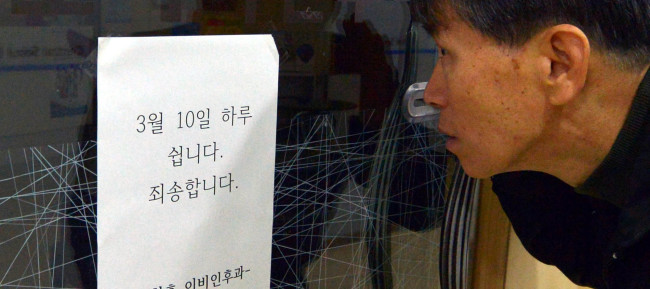Doctors lukewarm to strike
Government vows stern action against walkout
By Korea HeraldPublished : March 10, 2014 - 20:54
Thousands of Korean doctors staged a nationwide walkout Monday in protest of the government’s plan to allow telemedicine and for-profit subsidiaries under hospitals.
As of Monday afternoon, about 30 percent of the country’s clinics, a total of 8,300, had suspended their operations, according to the Ministry of Health and Welfare. The move was the first protest by doctors in 14 years. Emergency room and intensive care center staff were not involved in the one-day strike.
The protest grew in scale as medical residents decided to participate. About 42 percent of medical residents, 7,200 individuals, joined the move across the nation, including those working at Yonsei University Severance Hospital, one of the five largest medical institutions in Seoul.
As of Monday afternoon, about 30 percent of the country’s clinics, a total of 8,300, had suspended their operations, according to the Ministry of Health and Welfare. The move was the first protest by doctors in 14 years. Emergency room and intensive care center staff were not involved in the one-day strike.
The protest grew in scale as medical residents decided to participate. About 42 percent of medical residents, 7,200 individuals, joined the move across the nation, including those working at Yonsei University Severance Hospital, one of the five largest medical institutions in Seoul.

With the strike expected to cripple the nation’s health services, President Park Geun-hye vowed to take decisive measures.
“(The government) will definitely take stern action in accordance with the law and principles against those seeking abnormal collective interests and those damaging the public,” Park said during a meeting with senior presidential secretaries.
The Health Ministry issued a work resumption order to clinics that had closed for the strike. Doctors who disobey the order may face a work suspension of up to 15 days.
Prosecutors and police also vowed to seek criminal charges or suspend striking doctors’ licenses.
For its part, the Korean Medical Association criticized the government’s move, and warned that the measures will only result in bringing more doctors to its cause.
“The state is treating doctors as criminals. This will bring more opposition from doctors,” said KMA president Roh Hwan-kyu.
The KMA, however, left room for communication with the government.
“The situation came this far because problems couldn’t be solved through talks. (The government should) not let the public feel further anxiety but should find a solution through communication,” Roh said.
The KMA members and medical residents are planning to stage a second full strike from March 24 for six days. Emergency room and intensive care center workers are expected to join the second phase. Until then, strike participants will take part in a “law-abiding walkout,” which limits the medical consultation time to 15 minutes per patient. Medical residents will only work for eight hours a day.
About 1,500 medical residents also criticized the government’s plan to introduce telemedicine and for-profit entities under hospitals.
“Telemedicine forces doctors to diagnosis and prescribe mechanically. The government is also inducing hospitals to earn money through establishing for-profit subsidiaries,” said Song Myung-jae, the chief of a national medical residents group. He added that the government’s plans were tantamount to overlooking unlicensed medical care.
“We, the medical residents, wish to pursue real medical care. We want to choose an ethically right way of medicine by understanding patients’ pains and treating them scientifically.”
As the government and medical professionals continued their standoff, patients bore the brunt of the walkout.
Neighborhood clinics in Sejong City, which showed the highest participation rate, were shut down on Monday, usually the busiest day of the week, causing inconvenience for patients. Of the 58 neighborhood clinics in Sejong City, some 120 kilometers south of Seoul, 38 were closed.
Patients who were unaware of the strike had to search for the closest public health center.
Park Jeong-shik, father of an 8-month-old baby, went to a downtown pediatric clinic in the morning and appeared confused and upset.
“It’s absurd that patients are the victims of a fight between the government and doctors. I hear there is going to be a full strike, but they should have left at least one or two clinics open for emergency patients,” Park said.
By Lee Hyun-jeong and Suk Gee-hyun
(rene@heraldcorp.com) (monicasuk@heraldcorp.com)
-
Articles by Korea Herald








![[Graphic News] More Koreans say they plan long-distance trips this year](http://res.heraldm.com/phpwas/restmb_idxmake.php?idx=644&simg=/content/image/2024/04/17/20240417050828_0.gif&u=)
![[KH Explains] Hyundai's full hybrid edge to pay off amid slow transition to pure EVs](http://res.heraldm.com/phpwas/restmb_idxmake.php?idx=644&simg=/content/image/2024/04/18/20240418050645_0.jpg&u=20240419100350)







![[KH Explains] Hyundai's full hybrid edge to pay off amid slow transition to pure EVs](http://res.heraldm.com/phpwas/restmb_idxmake.php?idx=652&simg=/content/image/2024/04/18/20240418050645_0.jpg&u=20240419100350)

